 Rejuvenation Surgery
Rejuvenation Surgery
Aesthetic Surgery of the Face
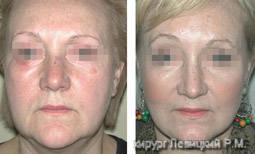
Before and after operation
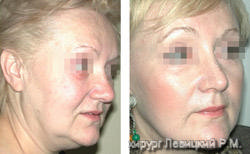
Before and after operation
Aging of the face is inevitable. As the years go by, the skin
begins
to loosen on the face and neck. Crow's feet appear at the corners of
the eyes. Fine forehead lines become creases and then, gradually,
deeper folds. The jawline softens into jowls, and beneath the chin,
another chin or vertical folds appear at the front of the neck.
Heredity, personal habits, the pull of gravity, and sun exposure
contribute to the aging of the face. As the aging population grows, it
is obvious why rhytidectomy has become the third most desired facial
plastic surgical procedure.
If you ever wondered how a rhytidectomy, or facelift, as
it is
commonly called, could improve your looks or self-confidence, you need
to know how a facelift is performed and what you can expect from this
procedure. This website can address many of your concerns and provide
you the information you need to begin considering facelift surgery.
Successful facial plastic surgery is a result of good
rapport
between patient and surgeon. Trust, based on realistic expectations and
exacting medical expertise, develops in the consulting stages before
surgery is performed. Your surgeon can answer specific questions about
your specific needs.
As with all facial plastic surgery, good health and
realistic
expectations are prerequisites. Understanding the limitations of
rhytidectomy is crucial and psychological stability is vital. There is
no ideal in a facelift. Rather, the goal is to improve the overall
facial appearance. Skin type, ethnic background, degree of skin
elasticity, individual healing, basic bone structure, as well as a
realistic attitude are factors that should be discussed prior to
surgery. This procedure is sometimes performed on patients in their
thirties, and successful surgery has been performed on patients in
their eighties. A facelift cannot stop aging, nor can it turn back the
clock. What it can do is help your face look its best and give you a
look of health and a more youthful appearance. A side benefit is that
many patients experience increased self-confidence.
Before deciding on a facelift, you should discuss with
your
facial plastic surgeon whether the overall effect will be more
successful if additional changes are made in the chin and neck areas
through other facial surgery. Many patients decide to have facial
liposuction to remove excess fatty deposits in conjunction with a
facelift. If several flaws need correction, more than one procedure may
be necessary for the best overall result.
Making the decision for a facelift
Your choice of a qualified facial plastic surgeon is of
paramount importance. During the preliminary consultation, the surgeon
will examine the structure of your face, skin texture, color, and
elasticity. Photographs will be taken so the surgeon can study your
face. Individual risks will also be examined, especially those related
to medical situations such as high blood pressure, a tendency to scar,
smoking, and any deficiency in blood clotting. The surgeon will take a
thorough medical history, as well as assess the patient's mental and
emotional attitudes toward the surgery. Because a realistic attitude is
crucial to the success of the surgery, the surgical procedure and
realistic expectations will be discussed.
After the decision to proceed with a rhytidectomy is
made
jointly by you and your surgeon, the surgeon will describe the
technique indicated, the type of anesthesia, the surgical facility, any
additional surgery, the pros and cons to include possible
complications, and costs of the procedure.
Understanding the surgery
The surgeon begins the incision in the area of the
temple
hair, just above and in front of the ear, and then continues around the
lobe, circling the ear before returning to the point of origin in the
scalp. The skin is raised outward before the surgeon repositions and
tightens the underlying muscle and connective tissue. Some fat may be
removed, as well as excess skin. For men, the incision is aligned to
accommodate the natural beard lines. In all cases, the incision is
placed where it will fall in a natural crease of the skin for
camouflage.
After trimming the excess skin, the surgeon closes the
incisions with fine sutures and/or metal clips, which permit surgery
without shaving hair from the incision site. Depending on the extent of
the surgery, the process can take from two to four hours. When the
procedure is performed with a combination of mild sedatives, local
anesthesia, and a mild intravenous anesthesia, the patient will
experience little discomfort. Some surgeons prefer to use general
anesthesia for facelifts. Following the surgery, the surgeon will apply
a dressing to protect the entire area where the incisions have been
made.
What to expect after the surgery
Even though most patients experience very little pain
after
surgery, the surgeon will still prescribe medication. Some degree of
swelling and bruising is unavoidable, and your surgeon may instruct you
to use cold compresses to keep swelling to a minimum. If a dressing has
been applied, it will be removed within one to two days. The surgeon
will also instruct you to keep your head elevated when lying down, to
avoid as much activity as possible, and to report any undue discomfort.
Though there are few risks in facelift surgery and thousands are
performed every year, some risk exists in any surgery.
In some cases, a drainage tube may have been inserted
during
surgery. This will be removed on the first or second day after surgery.
All sutures and staples are usually removed within five to 10 days
following surgery. Surgeons generally recommend that patients avoid
vigorous activity. Patients should prearrange for post-surgery support
from family and friends.
Recovery usually takes two to three weeks, though many
patients go back to work in two weeks. Scars are usually not noticeable
after enough time has passed for them to mature. In any case, they are
easily disguised in natural skin creases, by the hair, or, in
persistent cases, by makeup until total healing has occurred. Bear in
mind that theaging process continues after surgery and that some
relaxation of tissues will occur over the first few weeks.
Facial plastic surgery makes it possible to correct
many
facial flaws and signs of premature aging that can undermine
self-confidence. By changing how you look, cosmetic surgery can help
change how you feel about yourself.
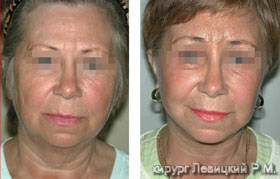
Before and after operation
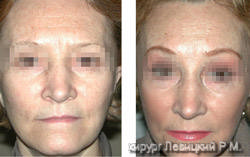
Before and after operation
Eyelid Surgery
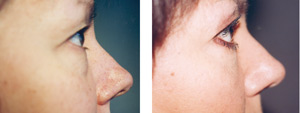
Before and after operation
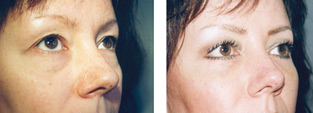
Before and after operation
Eyelid surgery or belpharoplasty is
a technique used to correct
drooping upper lids and puffy bags below your eyes. It uses a procedure
that removes fat along with excess skin and muscle from the upper and
lower eyelids to correct the features that make you look older and
tired. It is done alone or can be performed in conjunction with other
cosmetic procedures such as a facelift or a browlift.
This procedure works best for men and women over the
age of
30 who are physically health and realistic in their expectations. If
droopy eyes or baggy eyelids run in your family you may want to have
this procedure a little earlier. Certain health conditions can make
this procedure a little more risky.
By selecting a qualified plastic surgeon, and closely
following their instructions before and after the surgery, you can
insure that your chances of complications are very low, and any that do
occur are relatively minor.
You may experience some double vision or blurred vision
and
some swelling at the corner of the eyes. However, these are temporary
symptoms that should be gone within a couple of days.
Other more rare complications include difficulty
closing your
eyes after the surgery, and pulling down of the lower eyelid. If any of
these are present a subsequent surgery may be required.
Planning and preparing for
your
eyelid surgery
After selecting a qualified plastic surgeon, you will
proceed
to your initial consultation. Here, the doctor will perform a complete
medical exam. It is important that you make the doctor aware of any
health conditions you may have, if you use any types of drugs or
medications, or if you smoke. The doctor will pay close attention to
your eyes, testing your vision, tear production and examining any
glasses or contact lenses you may use.
This initial consultation gives you the opportunity to
discuss your goals and expectations for this surgery. Your surgeon will
explain the techniques and anesthesia that he will use and whether all
four eyelids or just the upper or lower ones will be done. Lastly, any
questions or concerns you have will be addressed, in addition to an
explanation of where the surgery will take place, the risks involved
and the cost of the procedure.
Your surgeon will give you precise instructions on what
types
of medications to take and not to take leading up to the day of your
procedure. He or she will also give some additional lifestyle and diet
recommendations that you should follow closely in order to minimize the
potential for any adverse side effects to the surgery. The surgeon will
also let you know if he feels that you should arrange for someone to
drive you home after the procedure and help you out for a few days.
Eyelid surgery
The procedure normally takes place in a surgeon's
office
facility but can also be done in a hospital. It is usually performed
under a local anesthetic coupled with medication that will make you
drowsy and relaxed - but awake - through the procedure. In some
instances, a doctor may choose to perform the surgery with the patient
under a general anesthetic, in which case you will be asleep of the
entire procedure.
The surgery itself can take from one to three hours depending on
how many eyelids will be done. The doctor will make incisions along the
natural lines of your eyelids: in the creases of your upper eyelids,
and just below the lashes in the lower lids. This will minimize any
visible scarring after the surgery. Working through these incisions,
the surgeon then separates the skin from the underlying fatty tissue
and muscle, removes excess fat, and trims any sagging skin and muscle
that is present. He or she will then seal of the incisions with very
small sutures.
After the surgery has been completed your surgeon will probably
lubricate your eyes with ointment and apply a bandage of some sort. You
may experience some tightness and soreness in your eyes at first which
is normal and easily treatable with some prescription medication from
your doctor.
Returning to normal
activities
After the procedure you should try to keep your head
elevated
for several days, and to use a cold compress on your eyes and head in
order to reduce and prevent any swelling or bruising that may occur.
Any bruising that is present should completely disappear anywhere from
two weeks to a month.
You may find that your eyes are somewhat "gummy" and
dry for
the first few days, and your doctor might prescribe some eye drops and
give you some instructions on how to clean your eyes at home. It is
also normal to experience some blurring, double vision, itching,
tearing and sensitivity to light in the days following your eyelid
surgery. These will all subside within a few days. The stitches will be
removed within a week and this will increase the speed of recovery from
these symptoms even more.
You will find that you will be able to do things like
reading
or watching television comfortably within a couple of days of your
surgery. You should avoid more strenuous activities like bending,
lifting, and sports for about three weeks. If you use contact lenses,
you will be instructed to not where them for at least two weeks after
this surgery since they may impede your recovery process.
By one to two weeks you will be ready to go back to
work and,
depending on your surgeon's recommendations; you may be able to wear
some makeup to hide any bruising that is still present.
During the recovery process you may find that your eyes
are
more sensitive to sunlight and wind so be sure to wear sunglasses and
eyelid sunblock whenever you go out.
The new you
Along with the thousands of others who have had this simple
procedure before you, you will find that the eyelid surgery will make
you look more alert and youthful. This new rejuvenated you will last
for many years and in some cases, the results are permanent.

Before and after operation
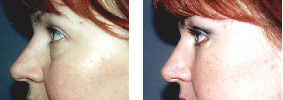
Before and after operation
Ear Surgery
Ear surgery or otoplasty is normally performed in order
to set
back prominent ears closer to the head or to reduce the size of large
ears. The procedure is normally done on children between the ages of
four to14; however, ears surgery on adults is also possible.
Since ears are almost fully grown by age four, by doing
this
procedure earlier, the less teasing and ridicule your child will face
while growing up. It is important that as a parent you stay alert to
your child's feelings about protruding ears. Do not force you children
into something they may not be ready for since children who want the
surgery are generally more cooperative during the process and happier
with the outcome.
In addition to protruding ears, ear surgery can help
with
other ear problems including:
-
lop ear, when the tip seems to fold down and forward
cupped ear, when the ear is very small shell ear, when the curve in the
outer rim and the natural folds
of the ear are missing lobes with large creases and wrinkles ear
reconstruction for those who were born without ears or who
lost them through injury
Ear surgeries are a common procedure, and when performed by a
qualified surgeon, carry little risk. However, as with all surgeries a
small chance exists that some complications will arise. Most of the
complications that arise are normally quite minor and can be dealt with
medically quite easily. A small percentage of patients may develop a
blood clot in the ear that can drain on its own naturally or drained by
a needle. Another possible complication is the presence of an infection
that will have to be treated by antibiotics or by drainage.
Planning and preparing for ear surgery
During your initial consultation with the surgeon, your
doctor will recommend the most effective technique for you or your
child after a thorough medical evaluation. He or she will also give you
specific instructions on how to prepare for the procedure.
Ear Surgery
The procedure normally takes place in a hospital or a doctor's
office and depending on the patient's age a general anesthetic (your
child will sleep through the operation) or a local anesthetic combined
with a sedative, so you or your child will be awake but relaxed.
Typically, general anesthetics are used for younger children whereas as
older children and adults are treated with local anesthetics.
The surgery itself will take about two to three hours
depending on how complicated the problem is and the age of the patient.
The surgeon will make a small incision in the back of the ear in order
to expose the cartilage beneath the surface of the skin. Then, the
doctor will sculpt the cartilage and bend it back toward the head or
remove a piece of cartilage, with non-removable stitches used to help
maintain the new shape. In most cases, a faint scar in the back of the
ear will be all that is left as evidence of this procedure.
Returning to normal activities
Unless you or your child was under a local anesthetic
during
the procedure, you should be up and about just a few hours after your
procedure. The patient's head will be wrapped in bandage in order to
best maintain the new sculpted shape of the ears and to promote quick
healing. Some people may experience some pain or throbbing in the ears
but that is easily treated with routine medications.
After a few days any bulky bandages will be removed
completely or replaced with a lighter dressing similar to a headband.
Any stitches will be removed or dissolve on their own within a week
following the procedure.
Since children can be very active, it is very important
that
you as a parent prevent them from doing any activities that might cause
the ear to bend. Children can go back to school after a week or so but
you want to ask your child's teacher to make sure that your child is
careful about playground activity etc. Adults can go back to work about
five days after the procedure.
The new look
Although some imperfection may remain after procedure,
most
patients are thrilled with the more natural looking ears of ear
surgery. Your child can lead a more normal school life and childhood
void of any ridiculing and adults can be more satisfied with a more
natural look
Endoscopic surgery of face, forehead and
breast
An endoscope is a fiber optic device that is utilized by
a
surgeon to carefully inspect structures deep beneath the skin and
subcutaneous tissues. Endoscopes are an integral tool in modern
surgery.
The above disciplines incorporate the endoscope to assist in
surgical treatments and procedures. During the 1990’s, the endoscope
became an extremely important part of nearly every surgical specialty,
including facial plastic surgery.
A small endoscope is a fiber optic tubular probe that assists
in
visualizing structures with precision. Magnification helps to delineate
subcutaneous structures. During endoscopic surgery the doctor will view
the surgical field either directly through the endoscope or by viewing
a television screen connected to the endoscope.
Endoscopic Advantages
Endoscopic surgery is a “minimally invasive” technique of
facial
plastic surgery resulting in less trauma then procedures used in the
past. For example, small incisions are required for the endoscopic brow
lift. Traditionally, a “coronal” incision was created for a brow lift.
This incision ran from one ear to the other, over the top of the head.
The coronal lift is now considered an outdated procedure and
essentially is no longer used. The advantage of an endoscope is that
minimal incisions are required. As few as two to five small incisions
are made behind the hairline, which nicely camouflages the subsequent
healing wound.
Aging of the upper eyes and upper forehead
Probably the first areas to show the signs of aging are the
regions
in and around the eyes and forehead. This is particularly noticeable in
one’s forties. Heredity, stress, poor diet, poor health, sun exposure,
and time all contribute to the severity of this aging process. These
time-related physiologic changes are also dependent upon each
particular individual’s response.
In one’s twenties, redundancy overlapping folds of skin and
laxity
(droop) of the upper eyelids slowly develops. It becomes more
noticeable in one’s thirties and particularly becomes noticeable in
one’s forties. With time, the eyebrows and forehead tend to become lax
and to droop into a position that is much less aesthetically pleasing.
The resultant may leads to an angry, fatigued, depressed, and/or tired
appearance. Horizontal forehead lines develop due to an individual’s
consistent attempt to elevate the eyebrows and open the eyes widely. In
some cases, this action may be necessary to see. The appearance of the
eyes and their relationship to the brows significantly affect one’s
overall aesthetic and youthful appearance. Both sun exposure and time
are significant factors that play a role in changing the appearance of
youthfulness and health to the forehead and eyebrows.
Overall, the typical signs of aging of the upper eye and
forehead
region are prominent horizontal forehead creases, prominent glabellar
furrow, droopy eyebrows, and droopy upper eyelids. Commonly, all four
conditions will develop at the same time; however, sometimes only one,
two or three will develop in any one individual. The eyebrows and
forehead significantly affect the upper eyelids. Over time, as the
forehead and brows descend, the redundancy and fullness of the upper
eyelids increases. With correction of the position of the eyebrows, the
excess skin of the upper eyelids is oftentimes significantly
diminished. Forehead wrinkles develop due to a persistent tendency to
raise the eyebrows due to the sagging (ptosis) of the eyebrows. The
endoscopic brow lift resolves the prominence of forehead wrinkles. Deep
glabellar lines (worry lines between the eyes and above the nose) are
also removed. Overall, a combination of four significant areas of
concern are rejuvenated and repositioned with the endoscopic brow lift.
Specifically, the areas restored with the endoscopic brow lift are as
follows: 1) elevation of the descended eyebrow positions, 2) reduction
of the fullness of the upper eyelids, 3) reduction of the horizontal
lines of the forehead, and 4) diminished worry lines in-between the
eyes.
Advantages of the Endoscopic Brow Lift
In many decades past, youthful restoration of the upper
forehead
area was performed with the “coronal” brow lift technique. Essentially,
scalp and skin tissue were elevated, pulled backward, and removed. The
long (coronal) incision that extended from one ear to the other was
required to remove tissue. The disadvantages of the procedure were that
tissue, scalp and hair were removed and a scar from ear to ear was
permanent and could sometimes be seen, especially in the event of male
pattern baldness.
The traditional forehead rejuvenation surgery incorporating
the long
coronal incision is more and more a thing of the past. Clearly, the
most advantageous aspect of the endoscopic brow lift is that of the
minimal incisions and resultant minimal wounds located behind the
hairline. Generally speaking, three to five incisions are created and
all are behind the hairline. They hide reasonably and satisfactorily
well in the confines of the hair. Even individuals who have male
pattern baldness can have incisions that are created in such a manner
so as to minimize and camouflage the scar. In the past, individuals
with male pattern baldness could not undergo the coronal incision
forehead lift due to the unacceptable resultant scar. With endoscopic
minimally invasive techniques, forehead rejuvenation becomes a
possibility for many. Additionally, scalp tissue is essentially not
removed in the procedure and there is basically no hair loss.
The Procedure
Endoscopic brow lift is performed under I.V. sedation with
local
infiltration with tumescent technique. The procedure takes
approximately one to two hours. Generally, between three to five
incisions are created behind the hairline. Commonly, three incisions
are created behind the upper portion of the forehead behind the
hairline. Each incision is approximately one to two centimeters in
length. A temporal incision (located above the ear in the temple area
behind the hairline) on each right and left side is created and extends
approximately two to three centimeters. The minimally invasive
technique of endoscopic visualization is performed utilizing the fiber
optic endoscope. Visualization in an exact plane beneath the skin,
scalp, and subcutaneous tissues is performed employing the endoscope to
visualize the tissues. Tissue is released and repositioned in an upward
fashion. The hairline is slightly raised. The eyebrows and redundant
eyelid skin are repositioned upwards concurrently. Pre-operative
measuring is done to assure that the desired repositioning is achieved.
Also, during the endoscopic procedure the forehead glabellar muscles
are trimmed. Specifically, the muscles of the central forehead, which
cause facial expressions of worry, concern and fatigue, are addressed.
From an aesthetic standpoint, it is beneficial to reduce or even
eliminate the ability of these muscles to function. A “muscle
sectioning procedure” is performed in the central portion of the
forehead during endoscopic visualization. Following the healing
process, the muscles will not work as well and the appearance and sense
of worriedness, fatigue and tiredness will be resolved at the same
time.
Inherent Risks
Bleeding is generally minimal during the procedure and is not
generally a concern postoperatively. Bruising and swelling are typical.
Incisions heal invisibly although sometimes the incisions can widen and
hair loss can occur in and around the incisions. This is typically
resolved after a three to six month period of time. It is rare for
incisions and scars to require repair or revision. Numbness to the
forehead and scalp is generally temporary; however, in rare instances
permanent numbness can occur. Of course, there are anesthetic risks
although I.V. sedation is a relatively safe procedure. A “surprised”
look is an unusual problem after a forehead surgery, as is persistent
brow ptosis. Scarring or pigmentation changes are also unusual. If
either condition occurs, then revision treatment is performed.
Nonetheless, the overall success rate is quite high when performed by
an experienced surgeon.
Postoperative Care
The wounds are closed with absorbable sutures and skin clips
are
placed in the scalp area. Pins are inserted into the bony cranium to
secure the positioning of the soft tissue, fascia, skin and scalp.
Individuals return home the evening of the procedure under the
supervision of a relative or friend. A head turban bandage is applied
which is removed the following day in the office. Generally, drains are
not required. It is recommended that the head be elevated in an upright
position to reduce swelling. Ice compresses are placed in and around
the forehead and eye area and are continued for approximately 36 to 48
hours. Pain medications of the codeine type are utilized. Patients will
experience some mild to moderate discomfort in and around the forehead
for 24 to 36 hours but the discomfort is reasonably controlled with the
oral pain medication. Ice compresses help to reduce the postoperative
discomfort. Anti-nausea medications are provided also, as they are
occasionally needed until the anesthesia metabolized out of the system.
The day after the procedure, the patient returns to the office for
removal of the bandage. Typically, individuals are able to resume
normal housework activities after two to three days and generally
speaking, individuals are able to return to work after five to seven
days. This is course, varies from person to person. Activities that
require exertion are not recommended until two weeks after the
procedure. Clips to the skin are removed approximately seven to
fourteen days after the procedure and pins to the cranium are removed
approximately two to three weeks subsequent.
|

 Rejuvenation Surgery
Rejuvenation Surgery








 DE
DE
 RUS
RUS
 ENG
ENG